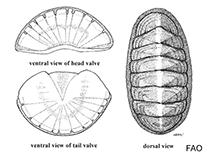Ischnochiton comptus (Gould, 1859)
Fancy chiton
Upload your photos
Google image | No image available for this species;
drawing shows typical species in Ischnochitonidae.
Google image | No image available for this species;
drawing shows typical species in Ischnochitonidae.
Classification / Names Common names | Synonyms | CoL | ITIS | WoRMS
Polyplacophora | Chitonida | Ischnochitonidae
Environment: milieu / climate zone / depth range / distribution range Ecology
Benthic. Subtropical
Distribution Countries | FAO areas | Ecosystems | Occurrences | Introductions
Western Pacific: Japan, south to the Philippines.
Length at first maturity / Size / Weight / Age
Maturity: Lm ? range ? - ? cm Max length : 2.5 cm TL male/unsexed; (Ref. 283)
Short description Morphology
Valves broad; mostly light grayish brown; variously blotched with white, cream, pink, reddish chestnut or blackish brown; some specimens are olive colored mottled with white. Valve surface microgranulose, sculptured with numerous weak, glossy, radiating riblets. Girdle scaly and colored in alternating yellowish and grayish or brownish bands.
Found from intertidal to 50 m, on rocks and gravel (Ref. 75835). Also found under stones, just before Sargassum (Ref. 128661).
Life cycle and mating behavior Maturity | Reproduction | Spawning | Eggs | Fecundity | Larvae
Members of the class Polyplacophora are mostly gonochoric. Life cycle: Eggs hatch into lecitotrophic planktonic trocophore larvae (no veliger stage) which later metamorphose and settle on the bottom as young adults.
Main reference
References | Coordinator | Collaborators
Burghardt, G. and L. Burghardt. 2006. (Ref. 283)
IUCN Red List Status
(Ref. 130435: Version 2024-2)
CITES status (Ref. 108899)
Not Evaluated
CMS (Ref. 116361)
Not Evaluated
Threat to humans
Harmless
Human uses
| FishSource |
Tools
More information
Trophic Ecology
Ecology
Population dynamics
Growth
Max. ages / sizes
Length-weight rel.
Length-length rel.
Length-frequencies
Mass conversion
Recruitment
Abundance
Max. ages / sizes
Length-weight rel.
Length-length rel.
Length-frequencies
Mass conversion
Recruitment
Abundance
Life cycle
Distribution
Human Related
Aquaculture profiles
Stamps, coins, misc.
Stamps, coins, misc.
Outreach
References
Internet sources
BHL | BOLD Systems | CISTI | DiscoverLife | FAO(Publication : search) | Fishipedia | GenBank (genome, nucleotide) | GloBI | Gomexsi | Google Books | Google Scholar | Google | PubMed | Tree of Life | Wikipedia (Go, Search) | Zoological Record
Estimates based on models
Price category
(Ref. 80766):
Unknown.



